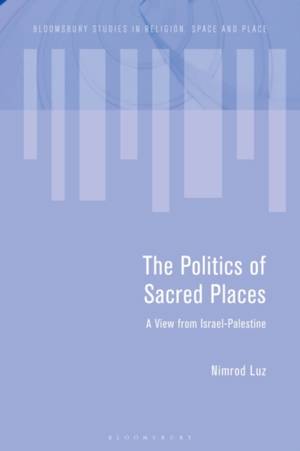
- Afhalen na 1 uur in een winkel met voorraad
- Gratis thuislevering in België vanaf € 30
- Ruim aanbod met 7 miljoen producten
- Afhalen na 1 uur in een winkel met voorraad
- Gratis thuislevering in België vanaf € 30
- Ruim aanbod met 7 miljoen producten
Zoeken
Omschrijving
The Politics of Sacred Places is a study of the socio-political dimensions of sacred sites in Israel-Palestine, drawing on over 20 years of in-depth ethnographic research which introduces cutting-edge theories on secularization, struggles for recognition, and diversity issues.
This book focuses on contemporary sacred sites and their socio-political meanings for minorities within a hegemonic and a secularizing state-system. It argues that sacred places provide a space that is less scrutinized by the state and where alternative visions of the socio-political may be produced.
A plethora of sites and case studies are examined, including the rural shrine of Maqam abu al-Hijja in the lower Galilee, the Mosque of Hassan Bek in the heart of Tel Aviv-Jaffa and the most disputed sacred place in the region, the Haram al-Sharif in Jerusalem. These sites are explored through mostly a phenomenological lens and in various contexts, from the individual body to the global.
This book offers a critical-analytical study of the socio-political aspects of sacred sites in contemporary societies within the broader understanding of scale and the spatial turn in the study of religion.
This book focuses on contemporary sacred sites and their socio-political meanings for minorities within a hegemonic and a secularizing state-system. It argues that sacred places provide a space that is less scrutinized by the state and where alternative visions of the socio-political may be produced.
A plethora of sites and case studies are examined, including the rural shrine of Maqam abu al-Hijja in the lower Galilee, the Mosque of Hassan Bek in the heart of Tel Aviv-Jaffa and the most disputed sacred place in the region, the Haram al-Sharif in Jerusalem. These sites are explored through mostly a phenomenological lens and in various contexts, from the individual body to the global.
This book offers a critical-analytical study of the socio-political aspects of sacred sites in contemporary societies within the broader understanding of scale and the spatial turn in the study of religion.
Specificaties
Betrokkenen
- Auteur(s):
- Uitgeverij:
Inhoud
- Aantal bladzijden:
- 240
- Taal:
- Engels
- Reeks:
Eigenschappen
- Productcode (EAN):
- 9781350295728
- Verschijningsdatum:
- 5/10/2023
- Uitvoering:
- Hardcover
- Formaat:
- Genaaid
- Afmetingen:
- 156 mm x 234 mm
- Gewicht:
- 512 g

Alleen bij Standaard Boekhandel
+ 390 punten op je klantenkaart van Standaard Boekhandel
Beoordelingen
We publiceren alleen reviews die voldoen aan de voorwaarden voor reviews. Bekijk onze voorwaarden voor reviews.








